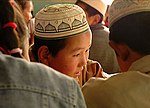Soyot (or Soyot–Tsaatan) is an extinct and revitalizing Turkic language of the Siberian Sayan branch similar to the Dukhan language and closely related... 14 KB (982 words) - 11:52, 1 May 2024 |
audio-visual language lab for teaching spoken Sanskrit. The language of the small-numbered Soyots in Buryatia, Russia, one of Siberian Turkic languages, has been... 26 KB (3,008 words) - 18:23, 29 April 2024 |
 | at the Wayback Machine – Glottolog Rassadin, V.I. "The Soyot Language". Endangered Languages of Indigenous Peoples of Siberia. UNESCO. Archived from... 97 KB (4,884 words) - 22:30, 29 April 2024 |
villages. The Soyot language of the small-numbered Soyots in Buryatia, Russia, one of Siberian Turkic languages, has been reconstructed and a Soyot-Buryat-Russian... 95 KB (10,536 words) - 12:34, 16 April 2024 |
Endangered Languages of Indigenous Peoples of Siberia. UNESCO. Retrieved 2021-07-15. Rassadin, V.I. "The Soyot Language". Endangered Languages of Indigenous... 24 KB (334 words) - 02:52, 19 December 2023 |
 | Shamanism in Siberia (category CS1 Russian-language sources (ru)) singing, and also shamanic songs of some cultures can be examples. In a Soyot shamanic song, sounds of bird and wolf are imitated to represent helping... 38 KB (3,729 words) - 05:42, 26 April 2024 |
 | Reindeer in Russia (section Soyot reindeer herding) shamanism, they spoke different languages. Vainshtein undertook expeditions to study reindeer-herders including the Soyot. In 1926, the ethnologist Bernhard... 22 KB (2,524 words) - 12:26, 13 May 2024 |
to as Soyons, Soyots or Uriankhais. Tuvan (also spelled Tyvan) is linguistically classified as a Northeastern or Siberian Turkic language, closely related... 30 KB (2,519 words) - 14:51, 5 May 2024 |
Mongolian language). Taiga Dukha or Tsaatan - spoken by the Dukha people of Tsagaan-Nuur county of Khövsgöl Province (nearly extinct) Soyot-Tsaatan language spoken... 41 KB (2,525 words) - 20:47, 12 March 2024 |
 | The languages of the Soviet Union consist of hundreds of different languages and dialects from several different language groups. In 1922, it was decreed... 39 KB (1,610 words) - 01:57, 20 April 2024 |
 | Dukha people (section Language) first appeared in the newspaper Ünen and began to replace terms such as soyot uriankhai, taigyn irged (English: "citizens of the taiga), and oin irged... 21 KB (2,398 words) - 20:26, 5 May 2024 |
 | The Mongolic languages are a language family spoken by the Mongolic peoples in Eastern Europe, Central Asia, North Asia and East Asia, mostly in Mongolia... 31 KB (3,308 words) - 06:17, 9 April 2024 |
Ethnic groups in Russia (category CS1 Russian-language sources (ru)) ctt1bh2kk5.13. Retrieved 2022-05-20. (including Dolgans 1939–1959) (including Soyots 1939–1989) (including Besermyan 1939–1989) (including Komi-Permyak in 1939)... 45 KB (1,117 words) - 09:34, 5 March 2024 |
extinct language may be narrowly defined as a language with no native speakers and no descendant languages. Under this definition, a language becomes... 162 KB (5,130 words) - 11:30, 13 May 2024 |
 | Tuvans (category Articles with Mongolian-language sources (mn)) 5% of all Tuvans. A people similar by language to Tuvans live in Okinsky District of Buryatia (autonym: Soyots (сойоты), sometimes referred to as Oka... 33 KB (3,519 words) - 14:50, 5 May 2024 |
hypothetical ancestor language of the modern Mongolic languages. It is very close to the Middle Mongol language, the language spoken at the time of Genghis... 5 KB (344 words) - 03:08, 10 March 2024 |
 | Tofalar (category CS1 Russian-language sources (ru)) territory. The Tofa language belongs to the Uyghur-Oghuz group of Turkic languages and is very close to the language of Tozhu Tuvans and Soyots. There are two... 17 KB (1,883 words) - 21:22, 29 April 2024 |
 | Wuhuan (redirect from Wuhuan language) modern Liaoning became the Wuhuan. According to the Book of Later Han, “the language and culture of the Xianbei are the same as the Wuhuan”. Until 121 BC, the... 10 KB (1,210 words) - 01:13, 8 April 2024 |
Valentin Rassadin (category CS1 Russian-language sources (ru)) best known for his documentation and studies of the Tofa language and Soyot-Tsaatan language. Rassadin was born in Pskov, Soviet Union on November 12... 12 KB (1,084 words) - 10:26, 5 December 2023 |
dialect of Uyghur language in the Karluk group of Turkic languages. Khoton learners are decreasing every year and considered an extinct language. Khotons use... 4 KB (297 words) - 20:53, 28 April 2024 |
 | Yugurs (category Articles containing Chinese-language text) They are mostly Tibetan Buddhists. The majority of Yugurs speak a Turkic language, while Mongolic and Chinese are also used in eastern provinces. The Turkic-speaking... 7 KB (558 words) - 13:30, 30 October 2023 |
 | Mongols (category Articles containing Mongolian-language text) Mongolia 2,986 Mongols proper, 461,389 Buryats, 183,372 Kalmyks, 3,608 Soyots (Russian Census (2010)) "Number of foreigners in Korea up for 1st time in... 98 KB (10,808 words) - 16:09, 12 May 2024 |
 | Dongxiangs (category Articles containing simplified Chinese-language text) different Central Asian language before shifting to their current mother tongue, Dongxiang language, a member of the Mongolic languages. The name Dongxiang... 18 KB (1,819 words) - 11:17, 3 May 2024 |
 | Tozhu Tuvans (category Articles with Russian-language sources (ru)) are reindeer herders. The language of Tozhu Tuvan people is a subdialect of Eastern (or Northeastern) dialect of Tuvan language.[citation needed] The Tozhu... 4 KB (306 words) - 11:45, 16 January 2024 |
Bonan people (category CS1 uses Chinese-language script (zh)) Whereas the Bonan language of Gansu has undergone Chinese influences, the Bonan language of Qinghai has been influenced by Tibetan. The language is also closely... 11 KB (1,212 words) - 01:48, 21 February 2024 |
Duan tribe (redirect from Duan language (Para-Mongolic)) Languages of Ancient Southern Mongolia and North China: a Historical-Comparative Study of the Serbi or Xianbei Branch of the Serbi-Mongolic Language Family... 6 KB (695 words) - 03:53, 8 May 2024 |




